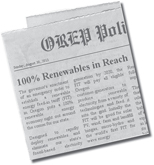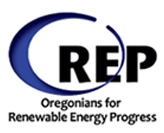Wisconsin First in Midwest to Introduce Feed-in Tariff Bill in 2010
January 7, 2010
By Paul Gipe
Powerful Wisconsin legislators were first out of the gate in a brewing race to be the first to pass feed-in tariff legislation in the Midwest.
Representatives Spencer Black (D-77th, Madison) and James Soletski (D-88th, Green Bay), along with cosponsors Senator Mark Miller (D-16th, Monona) and Senator Jeffrey Plale (D-7th, Milwaukee) introduced AB 649 on January 6th, 2010.
The bill, a comprehensive revision of laws governing energy and electric utilities in Wisconsin, was referred to the Special Committee on Clean Energy Jobs.
AB 649 includes a section creating a system of feed-in tariffs for renewable energy.
Assemblymember Black is chair of the Assembly's Committee on Natural Resources and Assemblymember Soletski is chair of the Committee on Energy and Utilities.
Senator Miller is the chair of both the Senate's Committee on the Environment and the Committee on Finance. Senator Plale is chair of the Committee on Commerce, Utilities, Energy, and Rail.
The bill's section on feed-in tariffs directs the state's Public Service Commission to determine the specifics of the program. After a lengthy docket in 2009, Wisconsin's PSC had deferred implementing its own feed-in tariff program without a clear mandate from the legislature. AB 649 is in part a result of the PSC's earlier inaction and a desire by Governor Doyle and the legislature to lead off the new year with action on climate change.
The bill must pass both the assembly and the senate and be signed by Governor Doyle before it becomes law.
Indiana, Michigan, and Minnesota legislators are also expected to introduce feed-in tariff bills this legislative session.
AB 649 includes provisions for wind, solar PV, biogas, and "other" renewable technologies. Only utilities with sales greater than 2.5 TWh per year will be required to offer the feed-in tariffs.
The bill's objective is "to maximize the development and deployment of distributed renewable energy generation technologies . . . without unreasonable impacts on electric utility rates."
Importantly, AB 649 stipulates that the price paid per kilowatt-hour must include the cost of generation for that type of generator, a reasonable rate of return, and any federal or state incentives, such as the federal renewable energy tax credit. Thus, the tariffs offered will not be based on "avoided cost" as in California, or the value of the electricity to the utility.
The PSC is to set limits on the amount of generation permitted under the program for each technology. As a consequence, there will be a rush by commercial developers to seize as many contracts as possible, potentially squeezing out homeowners, farmers, and small businesses from developing their own resources.
In a nod to a key provision in successful European policies and that in Ontario as well, the bill says tariffs "may" be based on different size classes within each technology. Creation of different size tranches within technologies, especially for solar PV, is regarded as a critical measure to prevent hoarding of contracts by large, multi-national developers.
Ontario, with five tranches of feed-in tariffs for solar PV alone, went even farther than that proposed in Wisconsin and set aside a special micro-FIT program for systems less 10 kW. Ontario also guaranteed expedited connection for systems less than 500 kW. Both measures were intended to insure that local residents and businesses could profit from the program despite the pressure from out of province and out of country developers.
Wisconsin's AB 649 assigns any renewable energy credits produced to the purchasing utility.
The bill also specifies that 6 percent of all electricity generated by 2020 must be produced from in-state renewable resources, and 10 percent by 2025.
In 2007, Wisconsin generated 60 TWh. The in-state 2020 target of 6 percent would require approximately 3.6 TWh per year. The 2025 target would require about 6 TWh per year from in-state renewables.
Under Wisconsin conditions, such a requirement could result in the installation of thousands of megawatts of wind or solar PV. Typical wind farms in the Midwest generate about 2,000 kWh/kW/year of installed capacity. Typical solar PV systems generate about 1,000 kWh/kW/year of installed DC capacity.
2020 Target Equivalents (3.6 TWh/year)
Wind ~1,800 MW, or
PV ~3,600 MW
2025 Target Equivalents (6 TWh/year)
Wnd ~3,000 MW, or
PV ~6,000 MW
AB 649 <http://www.legis.state.wi.us/2009/data/AB-649.pdf>
AB 649 History <http://www.legis.state.wi.us/2009/data/AB649hst.html>
Committee Chairs Propose Wisconsin Feed-in Tariff Legislation <Click Here>
-End-
More News on Feed-in Tariffs
Wisconsin First in Midwest to Introduce Feed-in Tariff Bill in 2010--Powerful Wisconsin legislators were first out of the gate in a brewing race to be the first to pass feed-in tariff legislation in the Midwest. . .
Jerusalem Post: Israel's Public Utilities Authority has finalized the tariff for the mid-size solar PV tranche from 50 kW to 5 MW <http://www.jpost.com/servlet/Satellite?cid=1261364529378&pagename=
JPost%2FJPArticle%2FShowFull> . . .
Updated Tables of Feed-in Tariffs Worldwide <http://www.wind-works.org/FeedLaws/TableofRenewableTariffsorFeed-InTariffsWorldwide.html> --including new solar PV tariffs in Israel. . .
Globe & Mail: 2009 biggest year yet for Canadian wind power <http://www.theglobeandmail.com/report-on-business/industry-news/energy-and-resources/2009-biggest-year-yet-for
-canadian-wind-power/article1413781/> --Ontario's new program is a "ground-breaking initiative," Mr. Hornung said, and not only because it's guaranteed pricing has made projects more financially secure. . . It also includes a streamlined project approval process, incentives for local manufacturing, and huge transmission investments that will make it easier to deliver wind power to the electricity grid. . .
Aussie Petition Drive: Let's get Australia moving on solar feed in tariffs! <http://www.feedintariff.com.au/> --Sign the petition and help Rudd choose a solar future! . . . says web site created by Energy Matters.
The Australian: Green power feasible <http://www.theaustralian.com.au/higher-education/green-power-feasible/story-e6frgcjx-1225810715413> --Australian Academy of Science . . . calls for a national system of feed-in tariffs, the price paid for green energy by householders and businesses into the grid. . .
Summary Statistics of Emissions Avoided, Fossil Fuels Offset, Imports Avoided, and Overall Cost Savings in Germany during 2008 from Feed-in Tariffs <http://www.wind-works.org/FeedLaws/Germany/SummaryStatisticsof
EmissionsAvoidedandFossilFuelsOffsetinGermany2008.html> --The following are just some of the data found in a report by the German government on the development of renewable energy. The data should put the lie to (but probably won't) il-informed or malicious charges that renewable energy development in Germany either doesn't offset any emissions of global warming gasses or doesn't offset the burning of any fossil fuels. . .
BMU on the Potential of Renewable Energy in Germany: PV and Onshore Wind 100 TWh Each <http://www.wind-works.org/FeedLaws/Germany/BMUonthePotentialofRenewableEnergy.html> --In 2008 Germany produced 15% of its electricity with renewables. The German government estimates that it can supply 92% of its electricity from renewables in the future. . .
New York Times: Feed-In Tariff 2.0 <http://greeninc.blogs.nytimes.com/2009/12/21/feed-in-tariff-20/> by John Lorinc--Just months after starting, a more lucrative version of Ontario’s feed-in-tariff program has attracted thousands of renewable energy investors, additional evidence that this particular policy lever, pioneered in Germany, can stimulate rapid growth in decentralized green power resources. . .
This feed-in tariff news update is partially supported by the Jan David Blittersdorf Foundation in cooperation with the Institute for Local Self Reliance. The views expressed are those of Paul Gipe and are not necessarily those of the sponsors.
Paul Gipe


